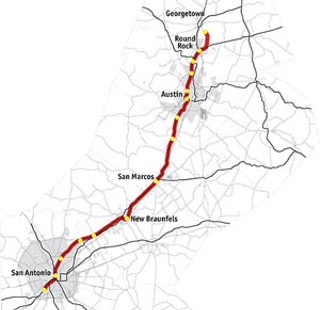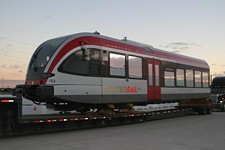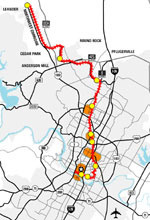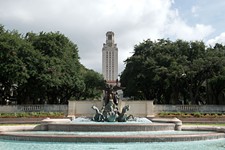Austin-SA Commuter Rail: Kyle looking on board
City of Kyle likely to be among first jurisdictions to support Austin-San Antonio commuter rail proposal
By Kimberly Reeves, Fri., Dec. 1, 2006

View a larger image
The city of Kyle is likely to be among the first jurisdictions to support the Austin-San Antonio commuter rail proposal, if only because it's most familiar with the types of financing vehicles that could support the line.
The Austin-San Antonio commuter rail proposal – not to be confused with Capital Metro's Leander-to-Downtown rail line – has been under discussion since 2003. The difference is not only in its route but in its financing vehicle. Despite some fits and starts, Capital Metro has managed to fund its starter rail line under one referendum to one group of voters for authorization of one bond issue. (A second bond referendum on a circulator system – actually about four times the cost of the starter line – will follow.)
The Austin-San Antonio Intermunicipal Commuter Rail District, on the other hand, is at the mercy of both the state and numerous local jurisdictions. Financing this 112-mile commuter rail line with 15 stations between Georgetown and San Antonio – which will run on a $40 million a year operating budget – will require $612 million bonds leveraged off local contributions and passenger fares, plus state rail relocation funds, plus annual operating funds already offered up by Capital Metro and VIA, San Antonio's transit authority. That's a lot of moving parts for the rail district to manage.
Months of meetings have discussed the viability of the rail project – projected costs and trip estimates – plus the best way to require the jurisdictions along the route to participate, either through the number of stations, the number of passengers, or the size of the jurisdiction. Austin and San Antonio, for instance, are the largest cities, and each has four stations. San Marcos may have only a single station, but that station may have a preponderance of passenger boardings if the rail line has, as expected, a broad appeal for college students going to and from both Austin and San Antonio. As one board member put it, the city of San Marcos could be penalized under such a plan for simply being too popular.
The rail district finally landed on numbers, and those numbers are being rolled out over the next three months to various agencies, from city councils to Capital Metro to the Capital Area Metropolitan Planning Organization. At a recent presentation of the rail district's proposal at Kyle City Hall, City Manager Tom Mattis and members of the City Council and Planning Commission were fairly receptive to the plan, despite the annual $1 million to $2 million price tag, which would be Kyle's portion of the bill.
That's because the money would come from a tax-increment financing district, set up by the city or county, around the proposed station. In Kyle, that station will be located on a greenfield site just outside the established and popular Plum Creek subdivision on FM 1626. Mattis says the area around the station – which the rail district predicts could bring in about $400 million in new tax base – is ripe for development. Kyle looks at the site and doesn't just see the rail station; it also sees the neighborhood retail and new tax base that will spring up around it. Despite its size, Kyle is no stranger to tax-increment finance districts, Mattis said. Much of the recent city infrastructure in Kyle, including enhanced gateway bridges and the new City Hall, was paid for through a TIF zone.
If the rail district gets significant buy-in from the jurisdictions along the line, the Georgetown-to-Austin line could be in operation by 2012. While no passenger fares have yet to be set, the one-way fare from Austin to San Antonio would likely be in the range of $12.
Got something to say on the subject? Send a letter to the editor.










